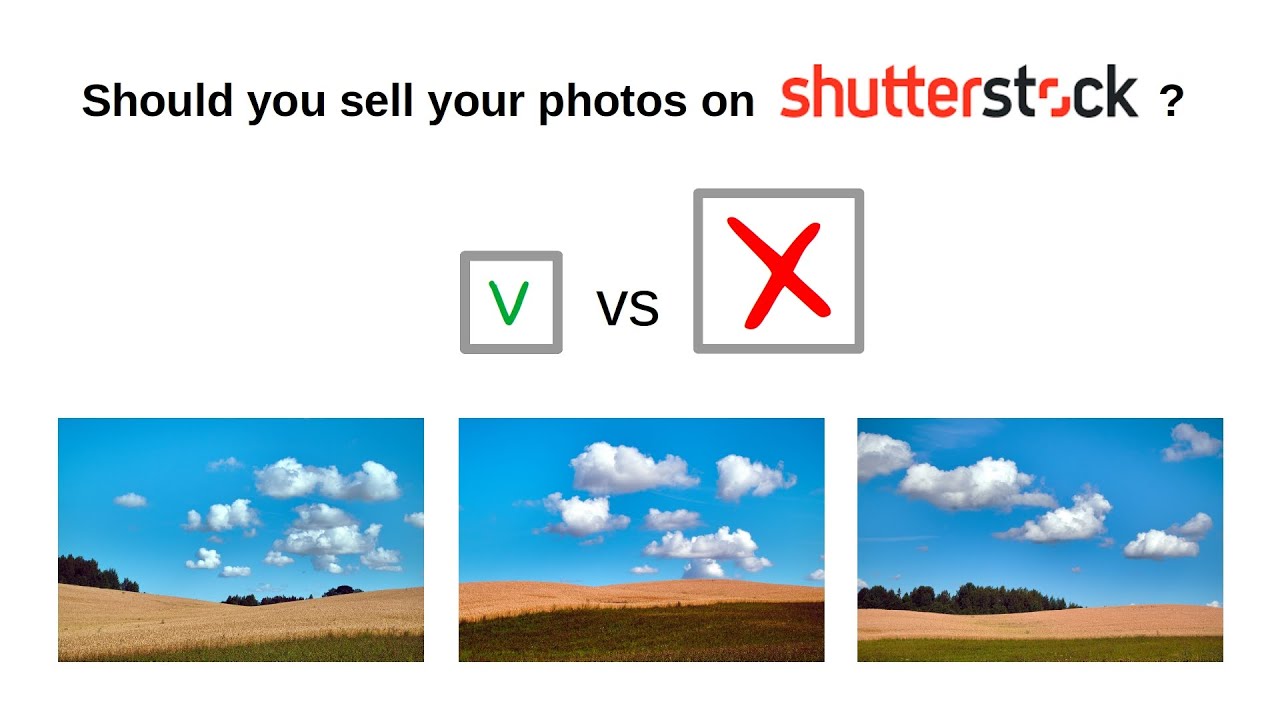If you’re passionate about photography and looking to turn your hobby into a source of income, Shutterstock might just be the platform for you. It’s one of the world’s leading stock photo websites, connecting photographers with millions of buyers worldwide. Whether you’re a professional or an enthusiastic amateur, Shutterstock offers a straightforward way to showcase your work and earn royalties. The key is understanding how the platform works, what types of images sell best, and how to optimize your submissions for maximum profit. So, let’s dive into the essentials to help you get started on your journey to selling your photos successfully!
Preparing Your Photos for Submission

Before you hit the upload button, it’s crucial to prepare your photos properly. High-quality, well-prepared images not only increase your chances of acceptance but also boost your potential earnings. Here’s a step-by-step guide to get your photos ready for submission on Shutterstock:
1. Review Shutterstock’s Content Guidelines
First things first, familiarize yourself with Shutterstock’s content guidelines. They have specific rules regarding image quality, subject matter, and model releases. Ensure your photos are legally compliant, especially if they include recognizable people, private property, or trademarks.
2. Focus on Image Quality
- Resolution: Upload images with a minimum of 4 megapixels, but higher resolutions are preferred.
- Sharpness: Make sure your photos are sharp and in focus.
- Lighting: Use natural or controlled lighting to avoid shadows and overexposure.
- Noise: Keep digital noise to a minimum, especially in low-light conditions.
- Color Balance: Ensure colors are natural and balanced.
3. Edit and Enhance Your Photos
Editing can make a big difference. Use photo editing software to crop, straighten, and enhance your images. Adjust brightness, contrast, and saturation to make your photos pop. Remember, avoid over-editing—aim for a natural look unless your style is intentionally artistic.
4. Tag and Categorize Effectively
Proper tagging helps your photos get discovered. Use relevant keywords that describe the subject, location, mood, and style. Be specific and avoid spammy tags. Additionally, categorize your images logically to match Shutterstock’s taxonomy.
5. Check for Model and Property Releases
If your photo features recognizable people or private property, secure the necessary legal releases. Upload these documents along with your images to avoid rejection.
6. Organize Your Portfolio
Maintain a well-organized library of your best work. Keep track of which images are ready for submission and update your portfolio regularly. Quality over quantity wins in the long run!
By taking the time to prepare your photos thoroughly, you’ll set yourself up for success on Shutterstock and maximize your earning potential. Remember, the more professional and polished your images are, the more likely they are to sell!
Understanding Shutterstock’s Requirements and Guidelines

Before you dive into uploading your stunning photos, it’s super important to understand what Shutterstock looks for in submissions. Think of it as the blueprint that ensures your images get accepted and stand out among thousands of others. When you know the rules, you can tailor your photography to meet their standards and maximize your chances of earning those royalties.
First off, Shutterstock has specific technical requirements. Your images should be in JPEG format, with a minimum of 4 megapixels. That’s roughly 2000 pixels on the shortest side—enough to keep your images sharp and professional-looking. The file size should be under 50MB, and images must be in RGB color mode, which is standard for digital images.
Now, onto content guidelines. Shutterstock is very particular about what they accept. They prefer images that are:
- Original and unique – your photos should bring something fresh and interesting to the table.
- High in quality – sharp focus, good exposure, and proper lighting are non-negotiable.
- Marketable – think about what buyers are looking for. Popular categories include business, lifestyle, technology, travel, and nature.
There are also some content restrictions. Shutterstock does not accept images that feature:
- Copyrighted or trademarked material without permission
- Obscene, violent, or hateful content
- Images of identifiable people without model releases (more on that later)
- Weapons, drugs, or illegal activities
Finally, understanding model and property releases is key. If your image contains recognizable people or private property, you’ll need the appropriate release forms. Without them, your images might be rejected or limited in licensing options. It’s a good idea to keep a folder of model releases handy and get signed copies whenever you shoot portraits or private property.
By familiarizing yourself with these requirements and guidelines, you’re setting yourself up for success. It’s all about creating content that’s not only beautiful but also compliant, making it easier for Shutterstock’s review team to approve your work—and for you to start earning from it!
Tips for Creating High-Quality and Marketable Images

Great photos don’t happen by accident—they’re the result of thoughtful planning, technical skill, and an eye for what buyers want. If you want to maximize your earnings on Shutterstock, focusing on high-quality, marketable images is the way to go. Here are some insider tips to help you get there.
1. Master Your Equipment
Whether you’re using a professional DSLR or a good smartphone, understanding your camera’s capabilities is crucial. Learn how to control focus, exposure, and white balance. Sharp, well-exposed images instantly look more professional and are more likely to be accepted.
2. Focus on Composition
The rule of thirds, leading lines, framing—these are all simple tricks to make your images more visually appealing. Take your time to set up shots that are balanced and engaging. A thoughtfully composed photo grabs attention and appeals to buyers looking for compelling visuals.
3. Pay Attention to Lighting
Natural light is often the best choice—shoot during golden hour (shortly after sunrise or before sunset) for warm, soft light. If shooting indoors, use diffused light sources to avoid harsh shadows. Good lighting makes your images pop and adds a professional touch.
4. Avoid Over-Editing
While some post-processing can enhance your photos, overdoing it can make images look unnatural. Keep edits subtle—adjust brightness, contrast, and color balance to enhance the original shot without losing authenticity.
5. Focus on Market Trends
Stay updated with current market trends by browsing Shutterstock’s popular categories. If travel photos of exotic locations are trending, or lifestyle images featuring diverse people are in demand, tailor some of your shoots accordingly.
6. Capture Authentic Moments
Stock buyers love genuine, candid shots that tell a story. Candid photos of people working, laughing, or engaging in everyday activities often perform well because they resonate emotionally and feel relatable.
7. Use Proper Keywords and Descriptions
Once your images are uploaded, don’t forget to add detailed, relevant keywords and descriptions. This makes your photos easier to find and increases the chances of sales. Think about what a buyer might search for—be specific and accurate.
By consistently applying these tips, you’ll not only improve the quality of your images but also make them more appealing to buyers. The goal is to create content that’s both beautiful and functional—images that people want to license for their projects. Over time, this approach can lead to a steady stream of income from your photography on Shutterstock!
Uploading and Tagging Your Photos Effectively

Now that you’ve got your stunning photos ready, it’s time to upload them to Shutterstock and make sure they get noticed. The key here is to be strategic with both your uploads and your tags. Think of this step as setting up a storefront — you want everything to be inviting and easy to find.
First, when uploading your images, choose the highest quality versions. Shutterstock has specific guidelines about resolution and size, so double-check that your photos meet their standards. Clear, sharp images with good lighting and composition tend to perform better. Also, include relevant metadata — titles, descriptions, and tags — that truly describe your photo.
Effective Tagging Tips
- Use descriptive, specific tags: Instead of generic words like “nature,” include specifics like “mountain landscape at sunrise” or “close-up of a bee on a flower.”
- Think like your customer: What keywords would someone search for to find your photo? Use those terms.
- Avoid overstuffing: While it’s tempting to add many tags, stick to the most relevant ones. Shutterstock recommends around 15-25 tags per image.
- Include synonyms and related terms: For example, if your photo features a “café,” also tag it as “coffee shop,” “coffeehouse,” or “cozy cafe.”
Writing Effective Titles and Descriptions
Clear, concise titles and descriptions help your images appear in relevant searches. Keep titles straightforward but descriptive, like “Happy family enjoying picnic in park.” Use the description to add context or details that might not fit into the title, including mood, setting, or any unique features.
Additional Tips
- Preview your tags: Use Shutterstock’s keyword suggestions to see popular search terms.
- Update tags over time: As trends change, revisit your images and optimize tags for better visibility.
- Stay consistent: Develop a tagging style that accurately reflects your portfolio’s focus.
Remember, effective uploading and tagging can significantly boost your images’ visibility, increasing the chances of making sales. Think of it as setting up a digital shopfront that’s easy to find and appealing to buyers!
Maximizing Your Earnings on Shutterstock
Now that your photos are uploaded and optimized, let’s talk about how to maximize your earnings. Shutterstock offers multiple ways to earn, and understanding how to leverage each can boost your income potential.
Understand the Contributor Earnings Structure
Shutterstock pays contributors based on their exclusive or non-exclusive status and the number of downloads. Typically, the more high-quality images you have, the higher your earning potential. Here’s a quick breakdown:
| Earnings Level | Download Count | Royalty Rate |
|---|---|---|
| Standard | Up to 1,000 downloads per year | 20-30% |
| Elite | Over 1,000 downloads per year | 30-40% |
| Exclusive Contributors | Any | Up to 50% |
Tips to Increase Your Income
- Upload consistently: Keep your portfolio fresh by adding new images regularly. The more quality images you have, the more opportunities for sales.
- Focus on trending topics: Stay updated on current events, seasons, or popular themes. Photos related to trending topics often sell faster.
- Offer a diverse portfolio: Include a variety of subjects, styles, and concepts to appeal to a broader audience.
- Promote your portfolio: Share your Shutterstock profile on social media, your website, or in online communities to attract more buyers and potential clients.
Utilize Shutterstock’s Promotional Opportunities
Shutterstock occasionally offers promotional features, such as highlighted images or themed collections, which can give your photos more exposure. Participating in these campaigns can lead to a spike in downloads and earnings.
Monitor Your Performance and Adapt
Regularly review your Shutterstock contributor dashboard. Pay attention to which images perform best and analyze why. Use this insight to guide your future uploads — focus on subjects, styles, or tags that generate the most income.
In summary, maximizing your earnings on Shutterstock isn’t just about uploading great photos; it’s about strategic presentation, continuous improvement, and understanding the platform’s earning structure. With patience and persistence, you can turn your passion for photography into a steady income stream. Keep learning, stay consistent, and watch your profits grow!
Promoting Your Portfolio to Increase Sales
You’ve uploaded some fantastic photos to Shutterstock—great job! But the work doesn’t stop there. Promoting your portfolio is essential to getting more eyes on your work and boosting your sales. Think of it as spreading the word about your photography masterpiece to the right audience. Here are some practical ways to do just that:
Share on Social Media
Platforms like Instagram, Facebook, Twitter, and LinkedIn are gold mines for exposure. Create dedicated accounts or pages for your photography and regularly share your Shutterstock portfolio links, behind-the-scenes shots, or stories behind your images. Use relevant hashtags to reach a broader audience, and engage with followers by responding to comments and questions.
Build a Personal Website or Blog
Having your own website not only showcases your best work but also allows you to control how you present yourself. Include a portfolio page with links to your Shutterstock profile, and consider writing articles about your photography process, tips, or stories behind your images. This boosts your credibility and can drive traffic directly to your Shutterstock uploads.
Leverage Photography Communities
Join online forums, Facebook groups, or communities like Flickr or 500px. Participate actively by sharing your work, giving feedback, and engaging in discussions. Many of these communities have sections for promoting your work or collaborations, which can lead to more exposure and potential sales.
Collaborate with Influencers and Bloggers
Partnering with influencers or bloggers who share your niche can be a game-changer. Offer them access to your images for their content, or suggest collaborations that highlight your photography. When they share your images, their followers become aware of your work—and many might visit your Shutterstock profile to see more.
Utilize Email Marketing
If you have a mailing list, send out regular newsletters showcasing your latest photos, special offers, or new collections. Provide links directly to your Shutterstock portfolio or specific images you’d like to promote. Personal touches like sharing your stories or tips can keep your audience engaged and interested in supporting your work.
Optimize Your Shutterstock Profile
Ensure your profile is complete, professional, and consistent. Use a clear profile picture, write a compelling bio, and organize your portfolio thoughtfully. The more professional and approachable your profile appears, the more likely potential buyers will browse and purchase your images.
Remember, promoting your portfolio is an ongoing process. The more consistent and genuine your efforts, the more visibility you’ll gain, and the higher your chances of making sales. It might take some time, but with persistence, you’ll see your Shutterstock earnings grow!
Common Mistakes to Avoid When Selling Photos on Shutterstock
Venturing into selling your photos on Shutterstock is exciting, but it’s easy to fall into some common pitfalls. Being aware of these mistakes can save you time, frustration, and even potential earnings. Let’s go over some of the most frequent errors and how to steer clear of them:
1. Overloading Your Portfolio with Low-Quality Images
Quality always beats quantity. Uploadting blurry, poorly lit, or uninteresting photos can harm your reputation and reduce your chances of making sales. Always curate your portfolio carefully, selecting only the best images that meet Shutterstock’s quality standards.
2. Ignoring Keyword Optimization
Keywords are your images’ best friends. Failing to use relevant, specific keywords can make your photos invisible to potential buyers searching for particular topics. Take the time to research popular search terms and include them thoughtfully in your metadata.
3. Not Respecting Copyright and Model Releases
Submitting images that infringe on copyrights or lack necessary model or property releases can lead to rejections or even account suspension. Always ensure you have the proper releases, especially when your photos feature recognizable people or private property.
4. Neglecting Trends and Market Demand
Sticking to outdated or overused themes can limit your sales potential. Stay updated on current market trends and popular topics. Incorporate fresh, relevant content that meets the needs of buyers today.
5. Inconsistent Uploading and Portfolio Maintenance
Uploading a few images and then neglecting your portfolio won’t help you grow. Regularly add new, high-quality photos and remove underperforming or outdated ones. Consistency keeps your profile active and attractive to buyers and Shutterstock’s algorithm.
6. Forgetting to Read Shutterstock’s Guidelines
Every platform has its rules. Not adhering to Shutterstock’s submission guidelines regarding image size, format, or content can lead to rejections. Familiarize yourself thoroughly with their requirements to streamline your submission process.
7. Expecting Immediate Results
Building a successful stock photography business takes time. Avoid getting discouraged if sales don’t happen overnight. Stay patient, keep improving your skills, and continue promoting your work.
8. Overlooking the Importance of Consistency in Style
While variety is good, having a recognizable style or niche can help you stand out. Don’t spread yourself too thin across unrelated topics. Focus on what you do best and what the market needs.
By being mindful of these common mistakes, you’ll set yourself up for a smoother, more successful journey selling your photos on Shutterstock. Remember, learning from mistakes is part of the process, and every misstep is an opportunity to grow as a photographer and seller!
Conclusion and Next Steps for Successful Selling
Congratulations on taking the first step toward turning your passion for photography into a profitable venture on Shutterstock. To maximize your earnings and build a strong portfolio, it’s essential to stay committed to continuous improvement and strategic planning. Remember, success doesn’t happen overnight, but with consistent effort, your images can generate sustainable income.
As you move forward, consider the following next steps to enhance your selling experience:
- Optimize Your Portfolio: Regularly update and diversify your collection to attract a broader audience.
- Stay Informed: Keep up with Shutterstock’s latest trends, guidelines, and keyword best practices.
- Engage with the Community: Join forums and social media groups for tips, feedback, and networking opportunities.
- Monitor Performance: Use Shutterstock’s analytics tools to identify top-performing images and understand market demand.
- Enhance Your Skills: Invest in photography courses or tutorials to improve your techniques and creativity.
Additionally, maintaining high-quality images that meet Shutterstock’s standards will ensure your work remains in demand. Experiment with different styles and subjects to discover what resonates most with buyers. Consistency and dedication are key to building a successful photo-selling business on Shutterstock.
In conclusion, by implementing these strategies and continuously refining your approach, you can turn your photography hobby into a profitable enterprise. Stay motivated, adapt to market trends, and keep creating compelling images—your success as a Shutterstock contributor is within reach.


